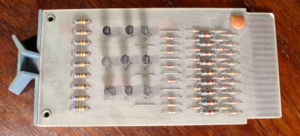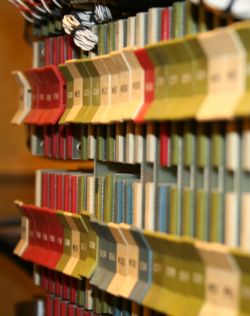FLIP CHIP

FLIP CHIP was DEC's trade name (a registered trademark for DEC) for a lengthy series of small cards used to build computers, and devices for them. It was a successor to DEC's earlier System Modules. The earliest FLIP CHIPs performed generic, simple functions, similar to an integrated circuit.
(They should not be confused with the generic technology term 'flip chip'; the DEC version, properly spelled with all capital letters, as in the trademark filing, got its name from the fact that some early FLIP CHIPs used flip chips. The latter was a component mounting technique which quite rapidly faded. The name was retained although the majority of Flip-Chips never really were flip chip-mounted, as it became apparent that the flip chip mounting technique was highly un-reliable.)
FLIP CHIPs were used in the DEC PDP-7 (referred to in documentation as the "FLIP CHIP"), PDP-8, PDP-9 and PDP-10, beginning on August 24, 1964.
They were introduced as a cost-reduction measure; a FLIP CHIP plugged directly into a 144-pin connector block backplane with wire-wrap pins on the back side; automatic Gardner-Denver wire-wrapping equipment could wire the connector blocks to produce larger functional modules.
Early FLIP CHIP modules were single-height, normal-length modules, approximately 4 inches long and 2.5 inches wide. These had 18 contact fingers on one side of the PCB only (the so-called 'solder' side); the contact pads were 'numbered' from the DEC Alphabet.
The earliest FLIP CHIPs, introduced in 1964, used discrete transistors. FLIP CHIPs incorporating IC technology soon followed, and the limited number of contact pins eventually became a problem, so that eventually contact fingers were added on the other ('component') side as well, for a total of 36 connectors, 18 on each side.
DEC continued to use the name up into the period when extended-length quad-height cards started to appear, e.g. in the KA11 CPU. However, although these special-purpose cards are labelled 'FLIP CHIP's, they are generally not considered to be 'true' FLIP CHIPS; the name is generally only used to refer to the smaller, general-purpose cards.
Contents
Naming
There appeared to be some confusion inside DEC at the time, as various manuals refer to it as "FLIP CHIP", "Flip Chip", "FLIP-CHIP", "Flip-Chip" and "Flip Chip", with trademark and registered trademark symbols.
Flip-Chip families

The various families were colour-coded, and the first letter denoted a colour, which was also visible on the handle.
A series
See the list of DEC parts.
The A stands for Amber. The A series were used for analog functions - ADCs, DACs, amplifiers etc.
B series
The B stands for Blue. The B series were used as core logic in the higher-end CPUs.
G series
The G stands for Green. The G series were used for "anything with non-standard voltages", I think.
M series
See the list of DEC parts.
The M stands for magenta. Part of this line is simple TTL-level logic, while later on, it became quite complex, see list of DEC part numbers. They replaced the R series which used discrete transistors with integrated circuits.
- Power supply: 5 V
- Operate at up to 6 MHz
R series
The R stands for Red. Slower logic than the B series, but cheaper. Used extensively in the I/O circuitry of computers.
- Slower logic than B series, cheaper
- Used in a variety of systems, e.g. PDP-8
- Power supply 10 and -15 volts
- Operational to 2 megahertz
- Signal level 0 volts, logic 0 and -3 volts, logic 1
- Typical price $20 to $30
S series
The S series is identical to the R seriese except that its transistors switch faster and lower resistance resistors, allowing more cards to be wired in series and operate somewhat faster.
W series
The W stands for White. These are components that plug into Flip-Chip sockets, but have no logic of their own.
External links
- In the Beginning and linked subsequent pages
- Digital Equipment Corporation PDP-7
- FlipChip Modules